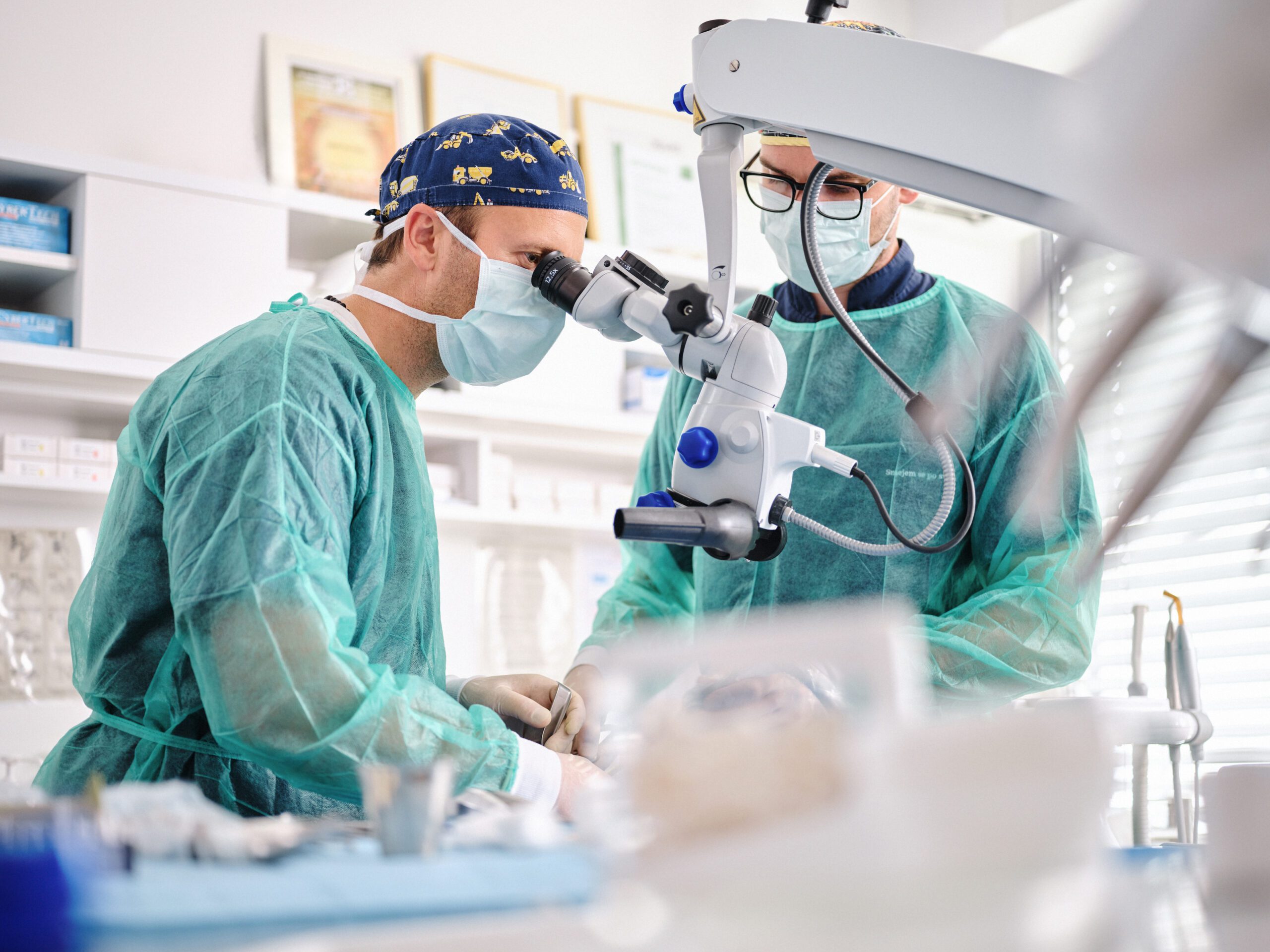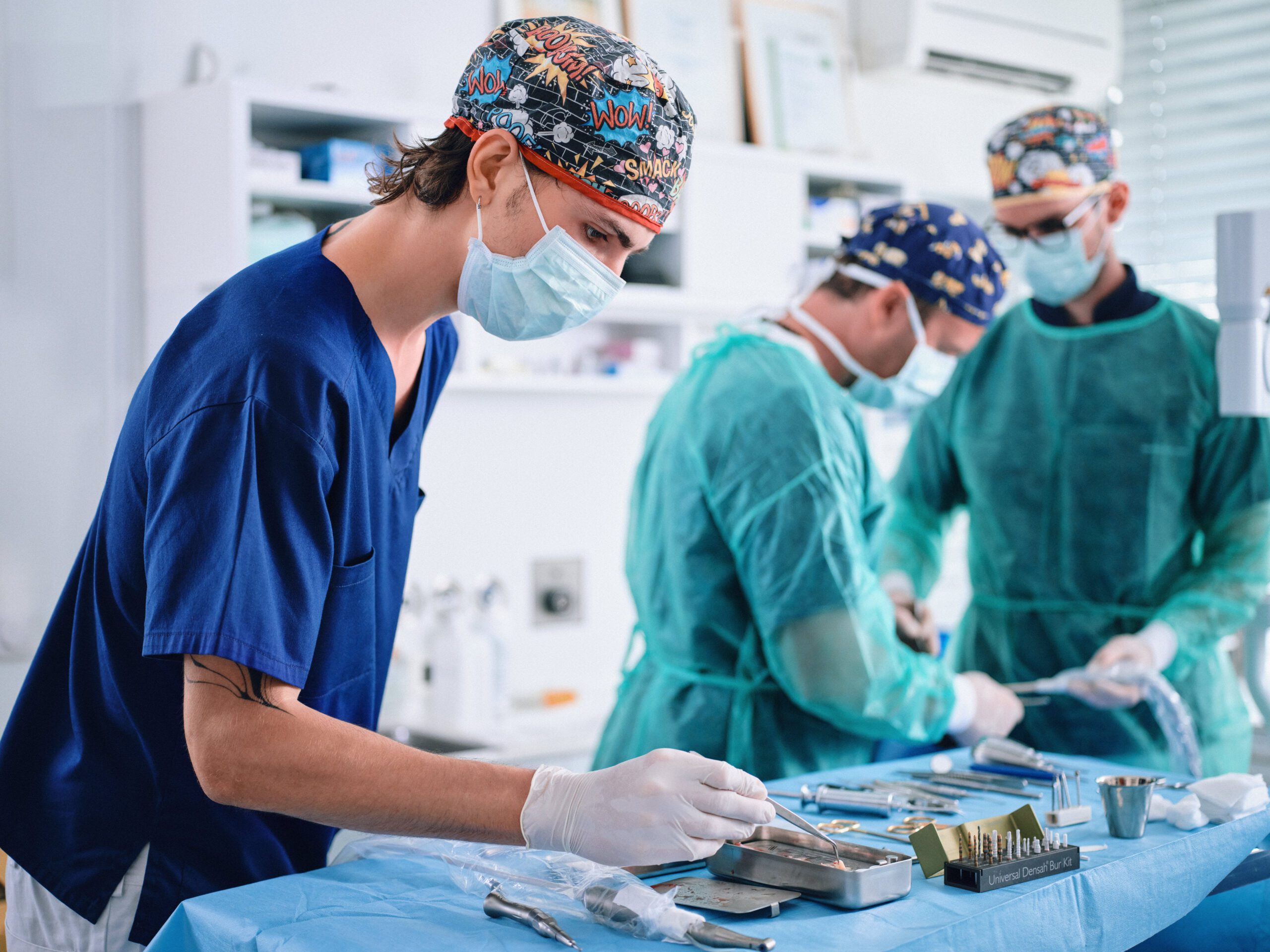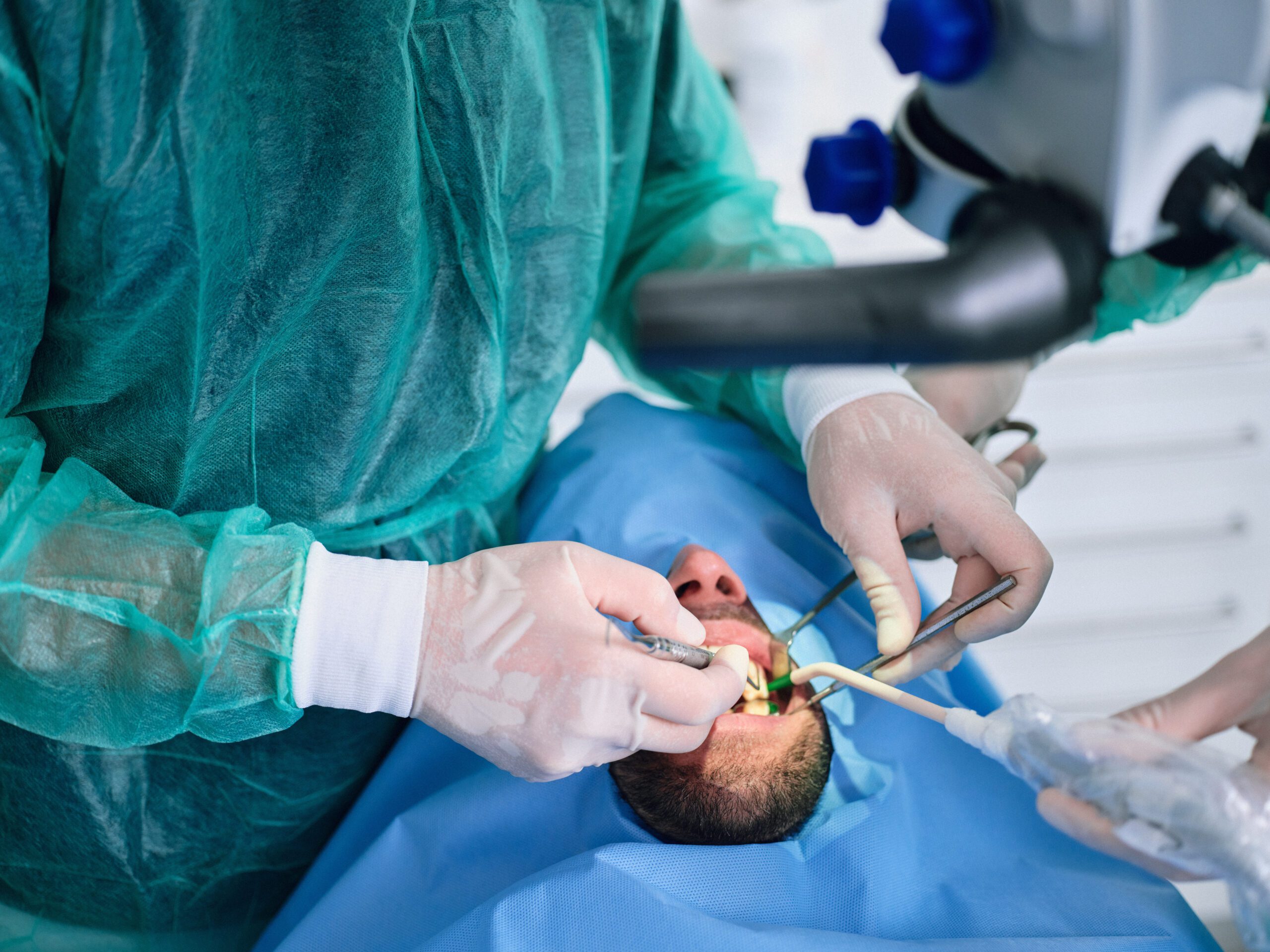Oral surgery is based on a modern and integrative approach that combines the latest technologies with thoughtful approaches to achieve optimal results. The philosophy stems from the belief that oral surgery must not only solve oral and dental problems, but also work in accordance with natural healing processes and be aware of the whole body, i.e. the mouth is in the body.
With you, the patient, at the center of attention, we prioritize minimally invasive techniques that shorten recovery time and minimize discomfort, while maintaining the highest standards of precision and efficiency. All procedures are performed with an operating microscope.
Integration of integrative preoperative and postoperative care
The field of oral surgery is constantly evolving to include not only advanced surgical techniques but also an integrative approach to care. A holistic philosophy that accompanies each surgical procedure is critical to optimizing healing, improving outcomes, and promoting overall well-being. This philosophy encompasses meticulous preoperative preparation, minimally invasive surgical techniques, and supportive postoperative therapies.
Preoperative optimization – The basis for successful surgery
Before any surgical procedure, it is essential to assess and optimize the patient’s nutritional status, which plays an important role in healing and recovery. Preoperative testing of serum vitamin D, folate, and vitamin B12 levels is an integral part of this philosophy. A lack of these nutrients weakens immune function, slows wound healing, and greatly increases the risk of postoperative complications.
Based on the results of the tests, in case of deficiencies, individualized regimes of taking nutritional supplements are prescribed, they are also available in the form of infusions. In addition, intravenous ozone autohemotherapy (AHT) is performed as an optional therapy. Ozone AHT has shown, very important for healing, improvement of oxygen delivery to tissues, modulation of the immune response and antimicrobial properties, thus preparing the body for surgery.
Day of surgery – Accuracy and minimal invasiveness
On the day of surgery, your blood is drawn to prepare advanced platelet-rich fibrin (A-PRF) and sticky platelet-rich fibrin (S-PRF) according to the protocols established by Choukroun. These autologous preparations are rich in growth factors and cytokines that promote tissue regeneration, reduce inflammation and promote healing. Incorporating A-PRF and S-PRF into surgical sites enhances the body’s natural healing processes.
Every oral surgical procedure is performed with minimal invasiveness in mind. This involves careful planning and execution to remove all infectious and non-infectious inflammation while preserving as much healthy tissue as possible. Minimally invasive techniques reduce trauma, reduce post-operative pain and shorten recovery time.
Intraoperative monitoring includes retesting vitamin D, folate, and B12 levels to ensure optimal nutrient status during surgery. Towards the end of the operation, an “up-building” local injection containing anti-inflammatory substances is applied. This targeted therapy helps reduce local inflammation, minimize pain, and support a healing environment at the surgical site.
Post-operative care – Support for recovery and well-being
Postoperatively, continuation of intravenous ozone AHT therapy is recommended to continue the benefits begun preoperatively, including improved oxygenation and immune system support. Also suggested is Papimi Magnetic Therapy, which uses pulsating electromagnetic fields to promote healing at the cellular level, reduce inflammation and relieve pain.
Necessary infusions, tailored to the patient’s needs, are provided to maintain hydration, restore nutrients, and support metabolic processes essential to healing. In addition to these therapies, specific supplements are suggested to further strengthen the body’s recovery mechanisms. These may include additional vitamins, minerals, antioxidants and herbal extracts known to support healing and immune function. It all depends on your blood test results.
Conclusion – Integrative approach for optimal results
This comprehensive philosophy of oral surgery emphasizes the importance of integrating nutritional optimization, advanced surgical techniques, and supportive therapies to improve outcomes. By addressing your physiological needs before, during and after surgery, we create a favorable environment for healing and recovery. This integrative approach not only aims to solve immediate surgical problems, but also promotes long-term oral and systemic health.
Adopting such a philosophy reflects a commitment to patient-centered care that recognizes that successful surgical outcomes are deeply intertwined with the overall well-being of the individual. With careful preparation, precise surgical intervention and supportive post-operative therapies, we strive for excellence in oral surgery and patient satisfaction.
Surgical extraction in integrative dental practice relies on minimally invasive techniques aimed at stimulating the body's natural healing processes.
This approach involves careful removal of the periodontal ligament and all “dead” tissue and careful preservation of healthy tissue. This prevents complications and speeds up bone healing after tooth extraction. Patients are surprised because even after the demanding surgical removal of the figure eight, they practically do not need a hospital stay.
Correct preparation for the intervention, the implementation of the intervention and the period after the intervention are key. Using freshly prepared ozonated water to wash the wound daily, pre-procedure centrifugation of platelet-rich fibrin (PRF) plays a key role in improving healing. Preservation of the surrounding bone and soft tissues is vital for planning future therapies, including implants and prosthetic rehabilitation.
Before extraction, it is important to thoroughly check the condition of the dentary bone and remove any remaining infections to prevent fatty degeneration of the bone, which can lead to chronic pain. It is also recommended to check the levels of vitamins D, B12, folic acid and LDL and HDL cholesterol, which are crucial for bone health and successful healing.
Bioceramic dental implants made of zirconium oxide bioceramics are becoming more and more popular, as they offer many advantages compared to classic metal titanium implants, which are Titanium Aluminum and Vanadium alloy marked Ti–6Al–4V.
This alloy contains 6% Aluminum and 4% Vanadium. We use advanced bioceramic solutions from the company Z-Systems, a leader in the field of bioceramic implants, which bring biocompatibility, durability and a natural appearance. This innovative technology enables long-lasting results and aesthetic perfection, which are important for a healthy and confident smile.
Advantages of bioceramic implants
Bioceramic implants, such as those from Z-Systems, are extremely gentle on the body. Their surface naturally repels bacteria, reducing the risk of inflammation around the implant – a problem that often occurs with titanium implants. Furthermore, bioceramic implants are completely metal-free, meaning they do not cause allergies or hypersensitivity or unexpected immune responses. In addition, they do not cause any “electrical” interactions with soft tissue that sometimes occur with metal implants, which contributes to a more pleasant experience.
A very important aspect is aesthetics. Bioceramic implants are naturally white in color, which enables a very harmonious appearance with natural teeth and gums. Unlike titanium implants, they do not cause a dark appearance of soft tissues, which is especially important in the front visible areas of the mouth.
Innovative Z-Systems technology
Z-Systems offers a wide range of bioceramic implants, such as Z5-BL (bone level) and Z5-TL (tissue level), which use the patented SLM® (Surface Laser Modified) surface. This surface enables faster and better growth of the implant to the jawbone. Clinical studies have shown that bioceramic implants completely compete with titanium implants in terms of quality, as they provide the same high level of success and long-term stability.
Z-Systems also offers something unique – a 100% bioceramic solution, including screws in the case of two-piece implants. Important research has confirmed the reliability and exceptional resistance of bioceramic implants to long-term loading and aging. It is an important breakthrough, as the results show that hydrothermal aging does not affect their long-term strength. We are grateful for the cooperation with prof. dr. Andraž Kocjan and dr. Aljaž Ivekovič from the Jožef Stefan Institute, with whom we are in close contact when choosing the best manufacturer.
<strong>Strength and durability of bioceramic implants</strong>
Research, such as the one conducted in 2023 by Kohal et al., has shown the exceptional durability of bioceramic implants made of zirconium oxide ceramics. Even after simulating a million chewing cycles and exposure to high temperatures, they showed no signs of material damage or degradation. This confirms that bioceramic implants are an excellent choice even for heavy loads.
A 2020 comparative study additionally showed that bioceramic implants are equivalent to titanium aluminum vanadium implants in terms of performance, while offering completely acceptable aesthetics and a significantly lower risk of complications.
Long-lasting results and performance. With long-term use of bioceramic implants, manufactured by Z-Systems, clinical research shows that these implants bring exceptional long-term stability. Many researchers have proven that bioceramic implants effectively maintain the healthy state of soft tissues, which is crucial for the success of treatment in the long term.
CONCLUDING REMARKS
If you are looking for a solution that combines aesthetics, sustainability and biocompatibility, bioceramic implants are the right choice. With their advanced technology, resistance to bacteria and natural aesthetics, they offer long-term health and functionality – all of which contribute to a confident and natural smile you’ll be happy to show off.
SOURCES
- Choukroun J, et al. An opportunity for the standardization and quality control of PRF. Growth Factors. 2006;24(4):243-9.
- Tunali M, et al. Two neglected biologic risk factors in bone grafting and implantology: High LDL cholesterol and low serum vitamin D. ResearchGate. 2013
- Z-System – www.zsystems.com​:contentReference[oaicite:14]{index=14}​:contentReference[oaicite:15]{index=15}
- Kohal R. et al. “Soft and Hard Tissue Integration of Zirconia Implants” – Journal of Oral Implantology
- Kohal R. et al. “Fracture Resistance of Two-Piece Zirconia Implants after Dynamic Loading and Hydrothermal Aging” – J Funct Biomater 2023
- Kohal R. et al. “Fracture Resistance of Two-Piece Zirconia Implants after Dynamic Loading and Hydrothermal Aging” – J Funct Biomater 2023
- Balmer M, et al. “Zirconia implants restored with single crowns or fixed dental prostheses: 5-year results of a prospective cohort investigation.” Clin Oral Implants Res. 2020
- Afrashtehfar KI, Del Fabbro M. “Clinical performance of zirconia implants: a meta-review.” J Prosthet Dent. 2020
-
Kocjan A, Cotič J, Kosmač T, Jevnikar P. In vivo aging of zirconia dental ceramics – Part I: Biomedical grade 3Y-TZP. Dent Mater. 2021 Mar;37(3):443-453. doi: 10.1016/j.dental.2020.11.023. Epub 2020 Dec 14. PMID: 33334584.
- Cotic Jasna, Kocjan Andraz, Panchevska Sanja, Kosmač Tomaž, Jevnikar Peter, 2020/12/01, In vivo ageing of zirconia dental ceramics — Part II: Highly-translucent and rapid-sintered 3Y-TZP, DOI: 10.1016/j.dental.2020.11.019, Dental Materials
MAHA
Slovenska cesta 54, 1000 Ljubljana, Slovenija, Europe
Tel. +386 51 248 888
email: info@maha.clinic
Mon, Tue, Wed: 8:00 – 15:00
Thu: 12:30 – 20:00
Fri: 8:00 – 13:30
© Copyright 2024 – Maha / made by visualbraingravity


